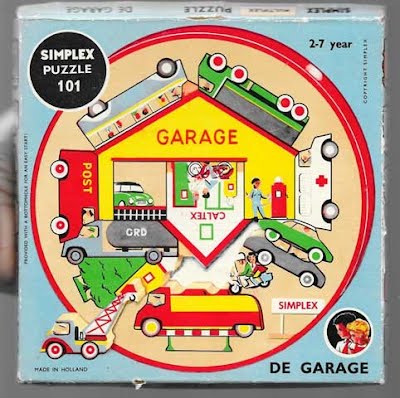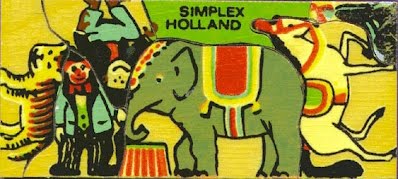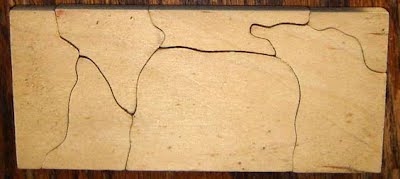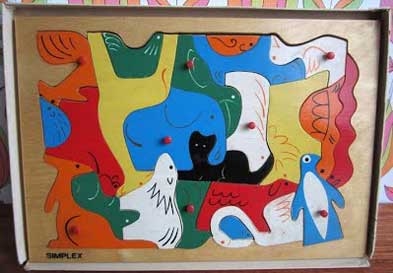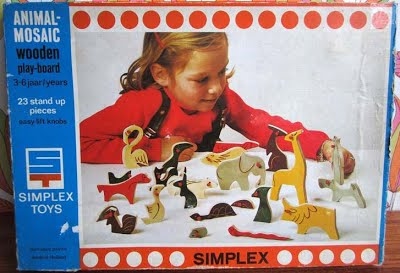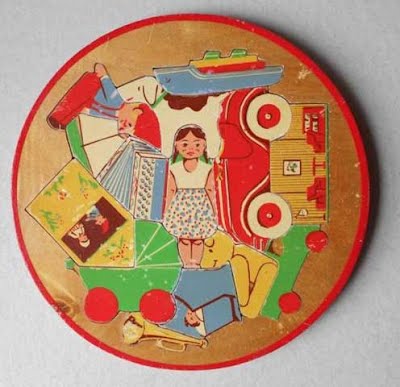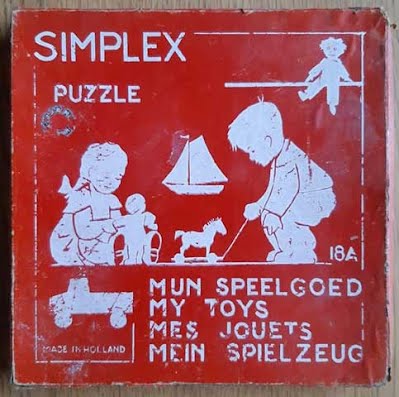Cluster Puzzles of the Simplex Company (c. 1945–1955 and c. 1972+) A study in three interrelated parts concerning the Simplex children’s toy company and their cluster puzzles. Part 1 is on the cluster puzzles and Part 2 on the company in general. Each part concentrates on one specific aspect, with references to the other aspect peripheral. Part 1 will thus likely be of the more interest to the intended cluster puzzle reader of the page. However, although Part 2 can be considered secondary, its inclusion is a great aid to understanding the cluster puzzles in the round, and so are thus included. Further, these stand as pieces on cluster puzzles and Simplex puzzles in their own right, and so will be of interest to any enthusiast of them or on the company itself. Part 3 is considered slightly apart from the above, of open questions, references, acknowledgements and a timeline. Introduction As a bald, simple statement, the cluster puzzles, of a circle and rectangular format, of the Simplex company, in the Netherlands, c. 1945–1955, and again of c. 1972, extracted from their general extensive children’s jigsaw puzzle range, are decidedly difficult to document and unravel in a variety of ways: 1. The company's history is relatively sparsely documented, despite being a major producer of the day. 2. The puzzles themselves generally lack a date, title and/or a serial number. 3. The cluster puzzle premise varies notably, seamlessly, from strong to weak, so much so that the weak end of the spectrum whether at times a tessellation premise is indeed intended is unclear. 4. Similar format children's puzzles, more or less contemporary, by W. Hahn, Kolibri and (to a lesser degree) Shackman muddy the waters as to attribution. Indeed, the Kolibri puzzles even echo the red rim of the Simplex puzzles. This being so, although I attempt to be my normal, thorough self in documenting, this particular entry is perhaps subject to revision more so than other entries. At times, it is not just frustrating but downright infuriating trying to unravel the various machinations! Part 1 Cluster Puzzles The Puzzles - Three Main Types of Format For the puzzles, I show typical instances of the three main types of formats, namely circle, small rectangle and large rectangle. These differ in the year of production, of c. 1945–1955 and c. 1972. Circle, c. 1945–1955 The Garage, left; box, right As can be seen, this 13-piece puzzle is a typical representative of the day, with a relatively small number of pieces. Around a central core, various vehicles then surround the garage, without any consideration of tessellation principles for their extremities. Therefore, this ‘disregard’ makes the task of realism of the outside vehicles a lot easier to achieve. Small Rectangle c. 1945–1955 Circus, front, left; reverse and reflected, right This 8-piece puzzle is of a decidedly lower standard in the Simplex range. In silhouette, of which I show the reverse reflected for purposes of comparison, the shapes are unrecognizable! All the artist has done is to draw interior circus themed detail inside an arbitrary boundary. There is no skill or imagination here whatsoever, hence the lower standard. Large Rectangle, c. 1972 Animal-Mosaic, left; box, right As can be seen, this 23-piece puzzle is of a much better standard of animal than previously, with more readily identifiable silhouettes. Further, there are no gaps, as with the circle and smaller rectangle instances. As the box indicates, and illustrates, these are also playthings in their own right. Although not dated as such, the box bears the Simplex logo as introduced by Fisher-Price, in 1972, hence the approximate date. Inventory I’ll begin by stating the inventory is subject to considerable revision, for reasons I detail below. At best, it is to be regarded as an interim version, with the possibility of error. A categorical count of the number of cluster puzzles is next to impossible; only an indication is possible as there are so many vagaries in interpretation, as detailed above. For the sake of general order, I place the puzzles alphabetically, by title. Numbers in brackets after my sequential numbers in the left-hand column are as given in documentation on the box. Where an official title is given, I thus use this. Where not, appended with an asterisk, I use a descriptive title of my own devising. For the format I simply state ‘circle’ or ‘rectangle’. The date is generally not known, beyond a rough approximation of c. 1945–1955. No. 6 is dated c. 1972. As such, without a single puzzle to hand, with only photos available, of varying degrees of clarity, it is not always a simple task to determine the exact number of pieces. Where this is so, I append each entry with circa. As to comments, I here I state the strength or otherwise of the cluster puzzle as to the tessellation principle, i.e. strong would be without gaps or overlaps, and weak would be of gaps, to greater or lesser degrees. Note that this does not necessarily correlate as to inherent high quality; it simply states the nature of the puzzle. Note that the Garage puzzles are particularly infuriating to document! Nico Stalenburg, a Simplex enthusiast and collector, in an overall inventory gives three instances, two puzzles of which are essentially the same, save for changes in livery! How to classify? For now, at least, I distinguish individually. Observations as to the Quality of the Puzzles The artwork here is typically of a decidedly lower standard than elsewhere. In silhouette, the shapes are to a great extent, unrecognizable. For instance, ‘Circus’, bears no resemblance to an even half recognizable motif! All the artist has largely done is to draw interior detail inside an arbitrary boundary. There is no skill here whatsoever. The same principle applies to the others, to equal or lesser degrees. Where an animal is clearly recognizable, such as the elephant in Circus, the artist here has merely begun with an accurate, proportionate life-like motif, to which he has then fitted other shapes around, typically of poor quality. However, this is partly explained by the pieces also being intended as play pieces in their own right, to be stood up. Even so, even with this condition, other puzzles are far superior. The Designer An open question is to who the designer/s were, whose name has not been recorded. In a question on this, Geert Bekkering, the noted Netherlands historical jigsaw authority told me told me (6 October 2017 email): The owners of SIMPLEX did the designing themselves. However, the 1972 puzzle can be seen to be noticeably different from the c. 1945–1955 puzzles, and can only have been designed by a different designer, who remains unknown. Large Rectangular-Shaped Puzzle of c.1972 Note that subsequently, in c.1972, Simplex produced one more cluster puzzle, of a larger rectangular format and with more motifs (23) but of a completely different kind, in which the inherent quality is much better, as well as of a truer tessellation principle, as shown above. These can only have been designed by a different person, who remains unknown. Likely, this was a Fisher-Price influence, the company having been taken over by them in 1970. Formats A variety of formats can be seen, namely of circles (c. 1945–1955), and two rectangles, described simply as small (c. 1945–1955) * x * and large (c. 1972+) * x *. Overall Assessment Type C puzzle (see the main page, the lowest), of typically 10–12 pieces, a noticeably low number. However, these are at least themed, albeit in this instance the lack of articulation makes such matters of little consequence. The puzzles, save for the c. 1972 instance, generally have issues with silhouettes and articulations and are sadly all too lacking, and so consequently these are some of the poorest examples to be seen. However, this is against my standard of a cluster puzzle, which is not necessarily what Simplex had in mind when they were designing! Therefore, the criticism here should be qualified. Selecting a best here is an onerous task, as they are generally lacking, of poor quality according to my standards. However, of the round puzzles, My Toys is broadly pleasing, whilst the Animal-Mosaic puzzle, above, does indeed have merit. My Toys, left; box, right Open questions on cluster puzzles 1. Are there yet more cluster puzzles waiting to be found? The Stalenburg inventory, although superb, is still far from being complete. 2. Was Frits J. van der Vlugt, as implied by Bekkering, indeed the designer? 3. What are the circumstances of the later c. 1972 puzzle, Animal-Mosiac? As ever, can anyone add to this? No detail is too small to mention. Part 2 Simplex the Company Simplex can be described as a major figure in the production of children's puzzles and learning aids, such as jigsaw puzzles, reading boards, playing boards, clocks and other toys in the Netherlands, beginning in c. 1945. Indeed, from an essentially two-person beginning, by Frits van der Vlugt and H. A. W. Steinmeier, these were then later made on an industrial scale. How many units is open to speculation; of a conservative estimate, there must be hundreds of thousands, even perhaps millions. However, they appear to have been a victim of their own success; the production process was so refined that it flooded the market, lessening the demand, and so closed in 1975. However, it can be seen to have continued in a sense under another name. Jumbo seems likely to have bought Simplex Toys in 2006. It continues to produce games and, in some cases, mobile app versions of its oldest toys. However, it is all very convoluted, of which I lack the desire to unravel. Many examples can easily be seen on auction sites, and at affordable prices too. However, despite being such a major company, with a relatively long history, there is very little detail known of them. What little is known of the company is largely due to the sterling efforts of three Netherlands people or institutions: 1. Will Hollander, the first employee, and of which the details below is an amalgamation taken from the above. 2. Betsy and Geert Bekkering, who wrote about the company relatively extensively in their book on Netherlands jigsaw puzzles, Stukje Voor Stukje: Geschiedenis van de Legpuzzel in Nederland. (In Dutch) 3. The Waalres Museum, near Eindhoven. However, even here, the detail is still noticeably sparse, of which for any one single text would not fill even one page of a word document! Nonetheless, what little there is at least gives an excellent guide. Each of these accounts I repeat below. What little is of my own research was largely peripheral, an enquiry to M. C. Escher’s son, George, as to if Escher knew of Simplex and the puzzles, and of which the reply, below, was most illuminating. For those of a broader interest in Simplex, Nico Stalenburg, of the Netherlands, a Simplex enthusiast and collector, has over 500 puzzles to his name, many of which are shown on his ‘Blauwprint’ (Blueprint) site. This is by far the premier site on the puzzles, at least in terms of illustration, with accompanying descriptions and cataloguing. However, it is not a history as such. The Company Background - Will Hollanders, Betsy and Geert Bekkering and The Waalres Museum 1. Will Hollanders, in Weekblad De Schakel Perhaps the best account, of a first-hand nature, comes from Will Hollanders, the first employee of the company. A story credited to him in Weekblad De Schakel gives the following: Frits van der Vlugt, a teacher from Aalst, came up with a concept that would become popular worldwide in the early 1940s: the Simplex puzzle. Teaching was in Van der Vlugt's blood and in order to let his son learn in a playful way, he made a puzzle. This was made of a wooden circle with smaller circular puzzle pieces with a button on it. His then 2-year-old son was able to pick up the pieces himself and put them back in the right place. Thus, in 1941, the first concept for the later Simplex puzzle was born. After the first, the same puzzle followed, but with color. Later the puzzle pieces also got a rectangular or triangular shape. The wood that Van der Vlugt used for his puzzles was the waste wood from 'Picus' from Eindhoven. This wood processing company produced receivers and speakers. And this is why the puzzles of the Aalst have a round shape. A (round) speaker belonged in a receiver. Picus sawed round holes from her wood for this purpose and Van der Vlugt retrieved the remaining circles. The popularity of the puzzles grew rapidly, because Van der Vlugt offered them to large toy stores in Eindhoven and the big grocers in the rest of the Netherlands. Everyone was enthusiastic about the original toys. To meet the big question, Van der Vlugt joined forces with the German Herman Steijnmeijer, whose daughters were in the class as students at Van der Vlugt. Together they decided to move the production of the puzzles from an attic room, where it was made until then, to Steijnmeijer's house, later a farm and later on a huge complex on the Gestelsestraat in Aalst. The demand for the puzzles brought about another change. The round shape was changed to a rectangle because Picus didn't make enough speakers to supply the number of round pieces of wood needed, By offering the puzzle - which was now called 'Simplex' - at toy fairs in Nuremberg, Germany, the product was distributed all over the world. Children from America to Japan played with the puzzles for decades until Simplex closed permanently in 1975 and the factory in Aalst disappeared. 2. Betsy and Geert Bekkering, pp. 57-58, translated: In the last year of the war Mr. F. J. van der Vlugt made toys of waste wood in the shed in his garden. He was a teacher and made toys just in his leisure time. He also had a boys club in Eindhoven. Just after the war he met Mr. H. A. W. Steinmeier, who had worked in a wood factory in Brabant. He made cigar boxes. Together they bought an old army hut and started toy production in Aalst (fig.82 and 83, page 57). Philips had no use for the round pieces of plywood that they cut out of the fronts of radio screens so the two men used these to make doll furniture at first. It was an English officer who suggested making them into round jig-saw puzzles. Thus the famous Simplex round puzzle discs were invented. The army hut soon became too small. In 1947 they rented farm buildings and in 1953 they moved to an old candle factory but it was too spacious so the rented some of this space to Philips. In the 1960's they were forced to move to Belgium to save money on labour as the minimum wages had been introduced in the Netherlands. In Belgium they prospered (fig.84, page 58). In the 1970's they became a daughter of Fisher Price and produced millions of puzzle discs a year. By automating their factory they could produce a puzzle in 2.2 minutes. The market was soon flooded with round puzzles and they stopped producing them in 1976. I am unsure as to his source; this contains different detail on occasion to the Hollanders account. 3. The Waalres Museum By ‘Misceaup’, of a 2 November 2015 Facebook posting, with the source given as The Waalres Museum. I have not been able to find the original on their website. It is perhaps no longer extant, although I have previously seen this (I think!) ‘Simplex, a piece of Brabant craftsmanship’ (Brabant = Dutch province) Laying plywood puzzles by Simplex was a welcome game for many Dutch children in the scarce years after World War II. In most houses you could find them. The collection of Simplex included toys and learning tools such as puzzles, clocks and reading planks. All of this was made of residual wood from the manufacture of radio cabinets for Philips. The first puzzle boards, which did not yet carry the name Simplex, are from World War II. The creator and first producer of the puzzle boards Frits van der Vlugt received a partner Herman Steinmeier in 1945. In 1946, the company moved to the residential house of Steinmeier in Aalst. In 1948, V.O.F. Steinmeier & Co. founded. Frits van der Vlugt was the creative power, while Steinmeier, who had been the manager of Wood industry Brabant, managed the course of woodworking. The Simplex factory, which has known various locations in Aalst, also produced in Budel after 1969 After 1972, manufacture took place in Kaulile in Belgium, but now under the flag of the American company Fisher Price Toys, part of The Quaker Oats Company. The factory in Belgium was closed in 1975 The Workshop Private Mines in Kerkrade bought the assets. Stocks and machines were auctioned in Aalst that same year. The brand name Simplex was sold females in 1975. The Simplex collection of toys and learning equipment has been donated by Will Dutch (Hollanders?), former manager of Simplex to Het Waalres Museum. The agreement of the donation includes that the museum makes an exhibition once every five years with the collection. M. C. Escher Interest Of interest with the Simplex puzzles is whether M. C. Escher knew of them, and if so did they influence his own works in this field, namely of Sun and Moon, Plane Filling I and Plane Filling II, of 1948, 1951 and 1957 respectively. Escher in his writings never mentioned Simplex. To this end, I then contacted George Escher, his son, for any possible thoughts on the matter. In a 5 March 2017 email he kindly told me: … I can tell you that although we were familiar with some Simplex puzzles, I cannot remember ever discussing their designs with father, or him showing any interest in them. When talking about Plane Fillings I and II he mentioned that he created them just out of curiosity, and that Plane Filling II allowed him to use "real" objects with "reality" constraints on their contour (e.g. the guitar), and also that he had the freedom to choose how many designs of one colour he wished to use to delineate a design of another colour. In general, the lack of constraints killed his interest in this kind of tessellation. From this, it would thus appear that the Simplex instances did not influence his work. A typical instance of a round puzzle Open Questions on Simplex the Company 1. Who was the ‘English officer’ who suggested these as stated by the Bekkerings? 2. Was Frits J. van der Vlugt, as implied by Bekkering, indeed the designer? 3. Is it possible to have an exact year for the introduction? 4. What was the year of Will Hollanders account in Weekblad De Schakel? 5. Is Will Hollanders still alive? It would be good to ask more from him. 6. What are the birth and death dates of Mr Frits J. van der Vlugt and Mr H. A. W. Steinmeier? 7. Are there references in books and articles? I am sure there must be, but there is little known. 8. What became of the Simplex papers? Is there an archive? As ever, can anyone add to this? No detail is too small to mention. Part 3 Other Aspects Open questions abound. A collection of all the questions above 1. Who was the ‘English officer’ who suggested these as stated by the Bekkerings? 2. Was Frits J. van der Vlugt, as implied by Bekkering, indeed the designer of the orignal puzzles? And who was the designer of the cluster puzzles of 1972? 3. Is it possible to have an exact year for the introduction? 4. What was the year of Will Hollanders account in Weekblad De Schakel? 5. Is Will Hollanders still alive? It would be good to ask more from him. 6. What are the birth and death dates of Mr Frits J. van der Vlugt and Mr H. A. W. Steinmeier? 7. Are there references in books and articles? I am sure there must be, but there is little known. 8. What became of the Simplex papers? Is there an archive? 9. Are there yet more cluster puzzles waiting to be found? The Stalenburg inventory, although superb, is still far from being complete. 10. What are the circumstances of the later c. 1972 puzzle, Animal-Mosiac? As ever here, does anyone know of further details of the above? No detail is too small to know. References Books Betsy and Geert Bekkering. Stukje Voor Stukje: Geschiedenis van de Legpuzzel in Nederland. 1988 (In Dutch) Translated: Piece by Piece: A History of the Jigsaw Puzzle in the Netherlands, pp. 57–58. ‘California Teachers Association’, 1955 A partial clipping as seen on Google Books of uncertain extent. CTA describe themselves as ‘The preeminent voice for educators in California’s public schools and colleges’ Web Nico Stalenburg, a collector and documentor of Simplex See the dropdown menus for ‘Simplex Puzzles’ and ‘Puzzle Collections’. Specifically for cluster puzzles, see Section A, Discs No. 1–30. Nico Stalenburg’s Facebook page on Simplex https://www.facebook.com/SimplexPuzzels/ A Facebook page run by Nico Stalenburg, including both cluster puzzles and ‘normal’ puzzles. Het Waalres Museum http://www.hetwaalresmuseum.nl/index.php?option=com_content&view=article&id=9&Itemid=15 Now just a generic link to the museum without the Simplex essay. ‘Round puzzle from Aalst worldwide hit’ https://www.weekbladdeschakel.nl/nieuws/algemeen/347595/ronde-puzzel-uit-aalst-wereldwijde-hit- A company history, as based on Will Hollanders account: ‘The stories of the first employee Will Hollanders from Aalst have led to this article’. The Bureau of Suspended Objects https://www.suspended-objects.org/post/136134905113/item-201-simplex-farm-animals-wooden-puzzle A curious page on reclaimed objects by Jenny Odell, of the US. Emails Private correspondence with George Escher, 5 March 2017 Timeline 1941. The concept for the later Simplex puzzles was born, as inspired by van der Vlugt's son. 1945. Van der Vlugt made toys of waste wood in the shed in his garden. c. 1946. van der Vlugt meets Mr. H. A. W. Steinmeier, who had worked in a wood factory in Brabant. 1946. The company moved to the residential house of Steinmeier in Aalst. c. 1955. Probably also started making jigsaw puzzles. 1960s. Forced to move to Belgium to save money on labour. 1969. Also produced in Budel. 1972. Manufacture took place in Kaulile in Belgium, but now under the flag of the American company Fisher-Price Toys. 1975. The factory in Belgium was closed. 1975. The brand name Simplex was sold. 1976. Stopped producing. Acknowledgements Nico Stalenburg, for much helpful discussion. Geert Bekkering, for correspondence. George Escher, for relating Escher aspects to the quest. Page created 8-9 April 2020 |
Cluster Puzzles >

